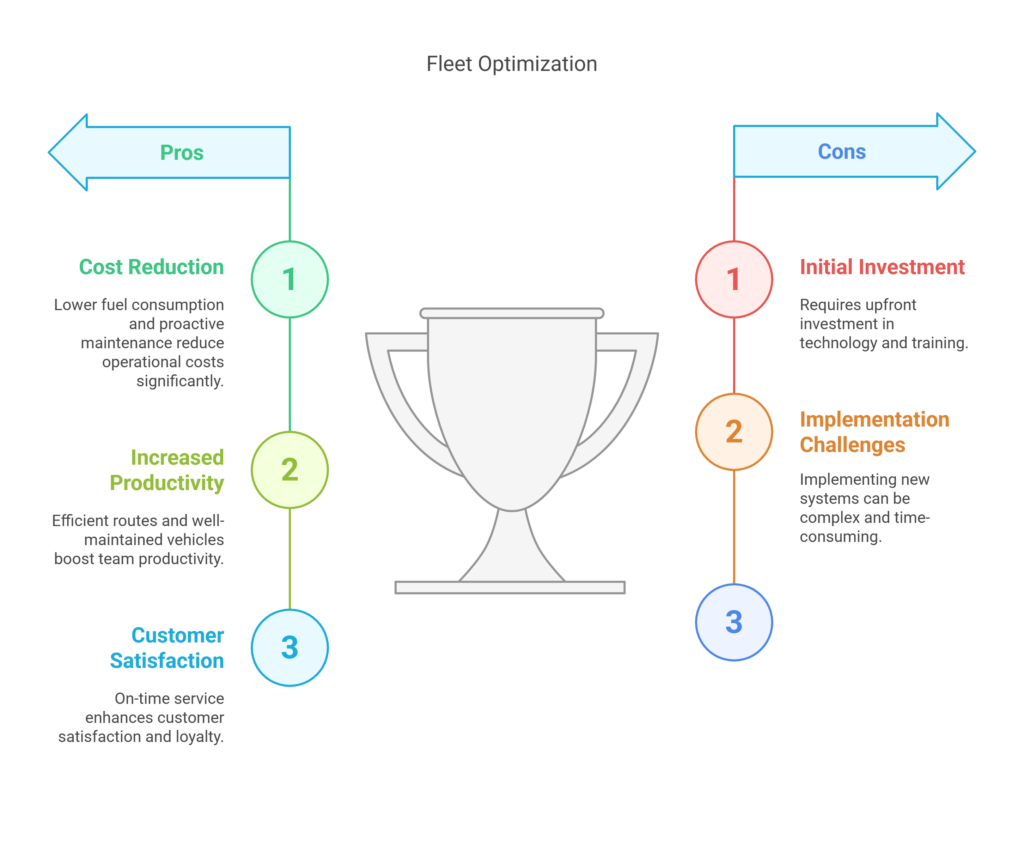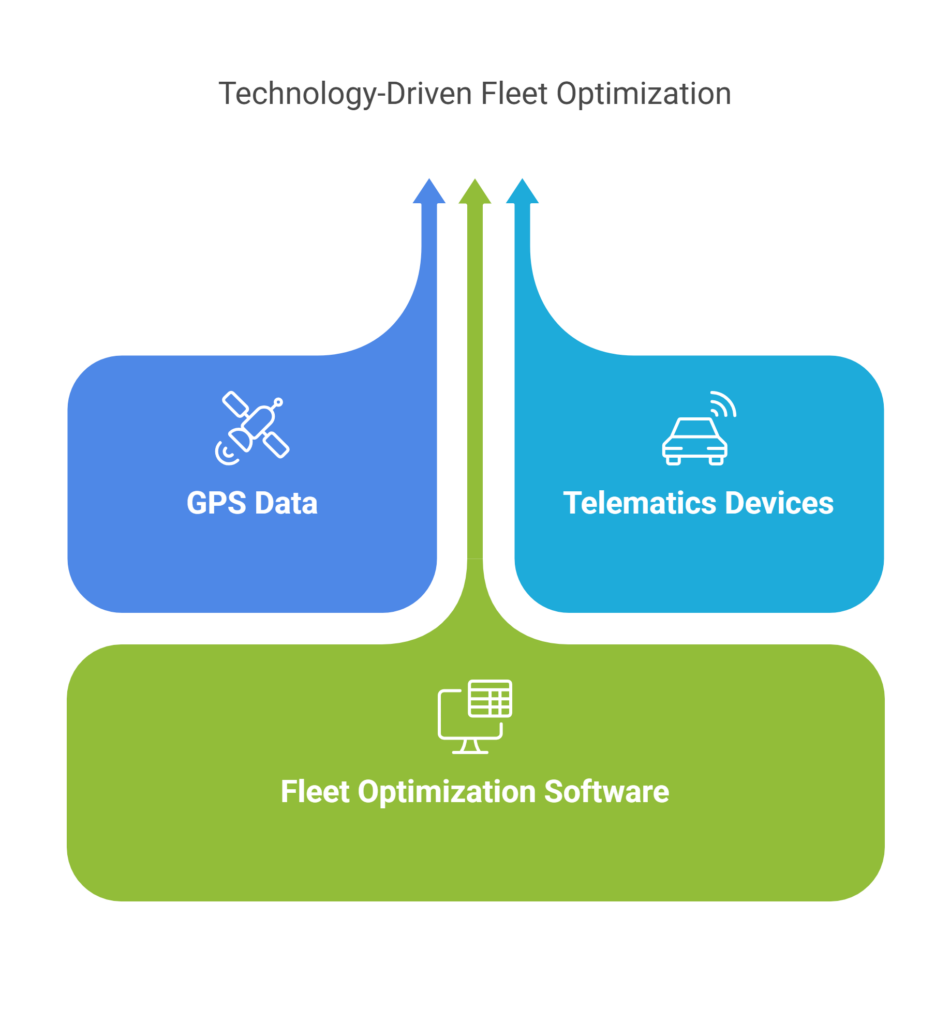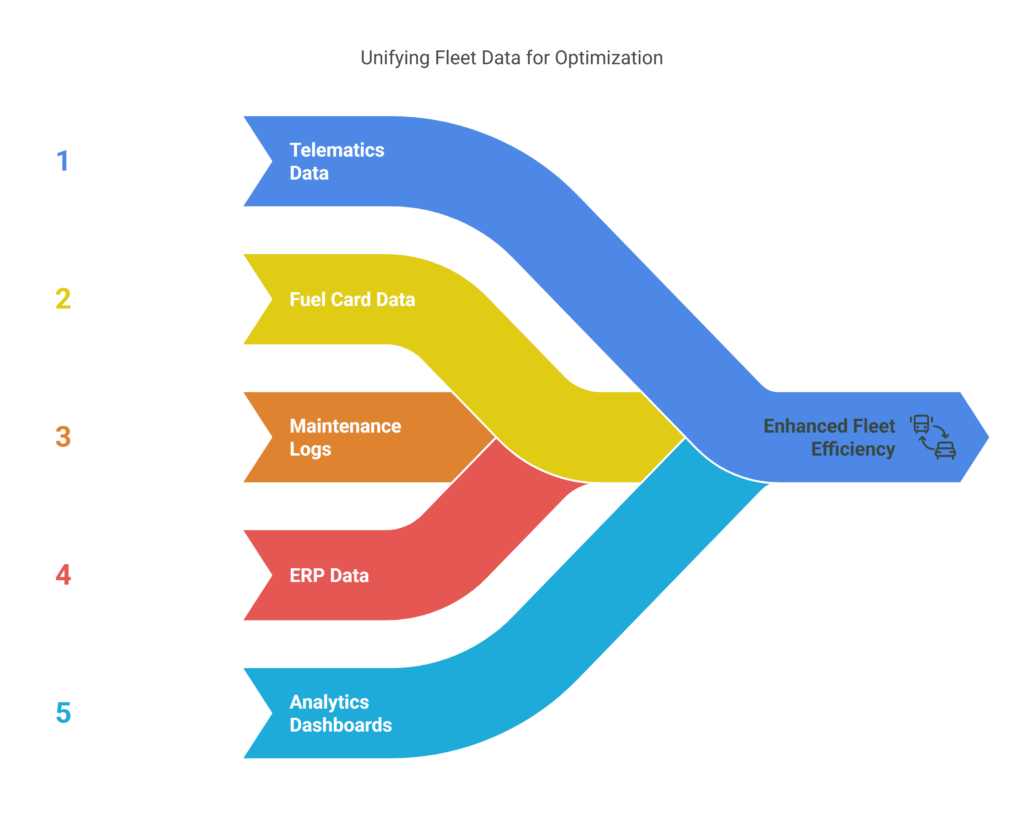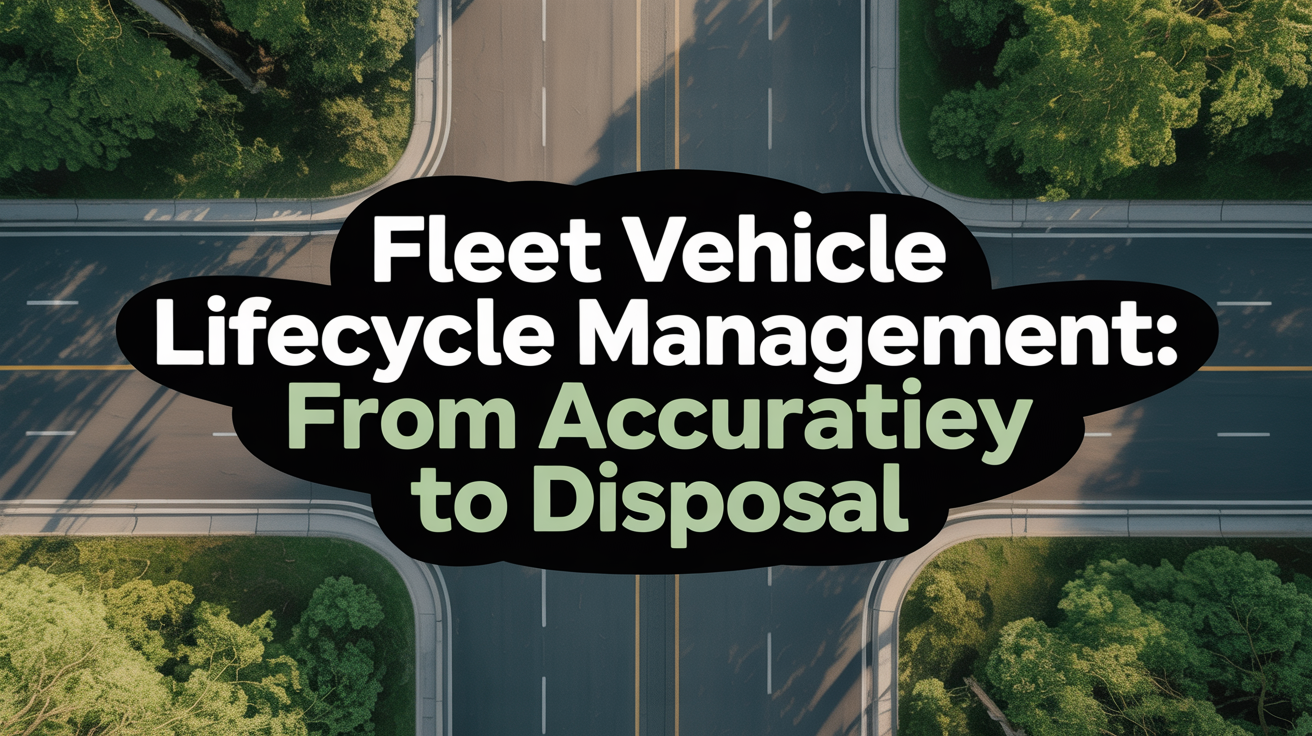Introduction
Delivery delays, escalating fuel costs, and unpredictable breakdowns can sabotage even the best-run fleets. Businesses relying on vehicle fleets often face shrinking margins and dissatisfied clients—not because they lack skilled drivers or quality vehicles, but because their fleet operations fall short of true optimization. Fleet optimization is the difference between simply dispatching vehicles and operating a synchronized logistics powerhouse. 🚚💨
By understanding strategic optimization, you can cut expenses, maximize vehicle use, and deliver better customer experiences while supporting sustainability goals. Here’s the core truth: data-driven decisions, streamlined routing, and proactive maintenance form the backbone of high-performing fleets. You’ll walk away knowing: how leading companies use technology for cost savings, why route and fuel optimization matter, and actionable strategies to modernize your operations for stronger ROI.
What Is Fleet Optimization?
So, what exactly is “fleet optimization”? Think of it as the smart, strategic layer sitting on top of day-to-day fleet management. It’s about proactively looking for ways to make your entire fleet operation run better, faster, cheaper, and safer. It’s not just tracking where your vehicles are; it’s about analyzing *why* they take certain routes, *how much* fuel they’re using, and *when* they’ll need maintenance *before* something breaks down.
This involves harnessing technology like GPS tracking and telematics, diving into the data generated, and making informed choices to improve efficiency, trim unnecessary costs, and ensure everything aligns with operational goals and compliance rules. It’s a continuous cycle of measure, analyze, improve, repeat. As Telnyx puts it:
- “Fleet optimization involves strategically using data and technology to improve a vehicle fleet’s efficiency, performance, and cost-effectiveness.”-Telnyx
Core Benefits of Fleet Optimization
Why put effort into optimizing your fleet? The advantages are pretty compelling. First off, the big one: cost reduction. Lower fuel consumption through smarter routing and monitoring driving habits directly impacts your bottom line. Proactive maintenance catches small issues before they become expensive repairs, cutting down workshop bills and costly downtime. 💰
Beyond savings, optimization boosts productivity. When routes are efficient and vehicles are well-maintained, your team can complete more jobs or deliveries in the same amount of time. Less time spent idling in traffic or waiting for roadside assistance means more time being productive. This improved reliability also leads straight to happier customers who appreciate on-time service. 😊

There’s an environmental angle too. Using less fuel means lower carbon emissions, helping your company meet sustainability targets and build a greener reputation. Plus, monitoring driver behavior doesn’t just save fuel; it promotes safer driving, potentially reducing accidents and insurance premiums. It’s a win-win-win scenario. As Teletrac Navman NZ notes:
- “Optimisation enhances fleet efficiency through effective strategies like reducing idle time, optimising routes, geofencing, and driver fatigue management.”-Teletrac Navman NZ
Fleet Optimization vs. Fleet Management: What’s the Difference?
It’s easy to mix up “fleet management” and “fleet optimization,” but they aren’t quite the same thing. Think of fleet management as the foundation – it covers the essential day-to-day tasks needed to keep a fleet running. This includes things like vehicle tracking, basic scheduling, ensuring driver compliance (like Hours of Service), logging maintenance, and managing vehicle acquisition and disposal. It’s about keeping the wheels turning and meeting basic operational needs.
Fleet optimization, on the other hand, builds upon that foundation. It’s a more strategic, proactive approach focused squarely on *improving* performance. Optimization uses the data gathered through management systems (and often adds more sophisticated analytics) to find inefficiencies and opportunities. It asks “How can we do this better?” rather than just “Is it getting done?”. While management might track fuel use, optimization analyzes that data to pinpoint wasteful habits or inefficient routes and then develops strategies to fix them. It’s about continuous refinement for peak performance.
Common Challenges in Fleet Optimization
Embarking on fleet optimization sounds great, but it’s not always a walk in the park. Businesses often run into a few common roadblocks. One major hurdle is dealing with data silos – information about fuel might be in one system, maintenance records in another, and driver logs somewhere else entirely. Without a unified view, getting the full picture needed for smart decisions is tough. 🤔
Outdated manual processes, like relying on paper logs or basic spreadsheets, also hold companies back. They’re time-consuming, prone to errors, and simply can’t provide the real-time insights needed for effective optimization. Sometimes, there’s resistance to adopting new technologies, either from drivers wary of being monitored or managers comfortable with old routines. Matching the right vehicle to the right job consistently and gaining true, real-time visibility into operations are other frequent pain points. Recognizing these challenges is the essential first step toward overcoming them.
How Technology Powers Modern Fleet Optimization
Technology is the engine driving modern fleet optimization. Without the right tools, you’re essentially flying blind. GPS provides the basic location data, but telematics devices take it much further, capturing rich information directly from the vehicle – things like speed, fuel consumption, engine diagnostics, harsh braking or acceleration events, and idle time. 📡
This flood of data is then channeled into sophisticated fleet optimization software. These platforms are the brains of the operation, analyzing the information to provide actionable insights through dashboards and reports. They automate route planning, track maintenance needs based on actual usage, monitor driver behavior for safety coaching, and streamline compliance reporting. The impact is huge.

Think predictive maintenance alerts that flag a potential issue before it causes a breakdown on the road. Or consider automated Hours of Service logging that saves drivers administrative headaches and reduces compliance risks. As Simply Fleet highlights, automation is key:
- “Fleet management software automates many routine tasks, reducing the administrative burden on fleet managers. This automation allows for better route planning, real-time tracking, and optimized scheduling, leading to increased productivity and reduced operational costs.”-Simply Fleet
Route Optimization: The Backbone of Fleet Efficiency
If there’s one area where optimization delivers immediate and obvious benefits, it’s routing. Fleet route optimization isn’t just about finding the shortest distance between two points on a map. It’s a complex calculation that aims to find the *most efficient* path for each vehicle, every single day. 🗺️ This means factoring in a whole host of variables.
Advanced software considers real-time traffic conditions, predicted weather patterns, delivery time windows specified by customers, vehicle capacity and load balancing, road restrictions (like height or weight limits), and even driver shift schedules. The goal is to minimize travel time and distance, which directly translates to lower fuel costs, reduced vehicle wear and tear, and improved on-time performance. As Safety Track explains:
- “Fleet route optimization is the process of determining the most efficient routes for vehicles to take in order to complete their tasks. This is done by analyzing real-time data, such as traffic conditions, weather, and vehicle performance, to determine the quickest and safest routes.”-Safety Track
Fuel Management and Cost Reduction Strategies
Let’s face it, fuel is almost always one of the biggest line items in a fleet’s budget. 💸 Keeping fuel costs under control is absolutely essential for profitability, and this is where optimization tools really shine. Simply tracking total fuel spend isn’t enough; you need visibility into *how* and *where* that fuel is being used (or wasted).
Optimization software, often integrated with telematics data and fuel card systems, provides granular insights. You can see fuel consumption per vehicle, identify excessive idling, spot potential fuel theft through discrepancies, and analyze how driving behavior (like speeding or rapid acceleration) impacts fuel economy. Combined with efficient route planning, this data empowers managers to set benchmarks, coach drivers on fuel-saving techniques, and make smarter purchasing decisions. As Coast Pay points out, even basic tech helps:
- “Even if the only tech that a fleet uses is fuel card software, the business will enjoy extensive control over everything fuel-related and will likely see a significant reduction in overall fleet expenses.”-Coast Pay
Maintenance Optimization for Fleet Longevity
Waiting for a vehicle to break down before fixing it is a recipe for high costs and operational chaos. Fleet optimization shifts the focus from reactive repairs to proactive, predictive maintenance. It’s about keeping vehicles healthy to maximize their lifespan and minimize unexpected downtime. 🔧✅
Technology plays a crucial role here. Optimization software tracks vehicle usage (miles driven, engine hours) and can even monitor diagnostic trouble codes reported by telematics devices. Based on manufacturer recommendations and real-world performance data, the system automatically schedules preventative maintenance tasks and alerts managers when service is due. Keeping detailed service histories digitally also helps track trends and ensure warranty compliance. As Simply Fleet notes, this structured approach pays dividends:
- “Regular maintenance is important for fleet longevity and performance. Fleet management software provides timely reminders and tracks maintenance history, ensuring vehicles are serviced as needed, preventing costly breakdowns, and extending vehicle lifespans.”-Simply Fleet
Boosting Driver Productivity and Safety
Your drivers are the heart of your fleet operation, and optimization efforts can support them in becoming safer and more productive. Monitoring solutions, using telematics data, can track driving behaviors like speeding, harsh braking, sharp cornering, and excessive idling. This isn’t about playing “Big Brother,” but about identifying patterns that indicate risk or inefficiency. 👍
This data provides objective grounds for coaching conversations, helping drivers understand how small changes in habits can improve safety and fuel economy. Many systems offer driver scorecards, creating opportunities for recognition and rewarding safe practices. Furthermore, optimized routes reduce stress and potential fatigue, while automated compliance tools (like electronic logging devices for Hours of Service) minimize administrative burdens, letting drivers focus on the road.
Sustainability and Environmental Impact
In today’s world, operating responsibly matters more than ever. Fleet optimization offers a clear path to reducing your operation’s environmental footprint. The most direct impact comes from reduced fuel consumption – efficient routes, less idling, and smoother driving all mean fewer greenhouse gas emissions pouring into the atmosphere. 🌍🌱
This not only helps meet increasingly stringent environmental regulations but also enhances your company’s reputation. Customers, investors, and employees often prefer businesses that demonstrate a commitment to sustainability. Optimization software can help track and report on key environmental metrics, like CO2 emissions per mile or per delivery, providing tangible proof of your green initiatives. As Telnyx states:
- “Efficient routing and reduced idle times lead to lower fuel consumption and reduced greenhouse gas emissions. This result matches up with the growing global emphasis on environmental responsibility.”-Telnyx
Key Metrics to Track for Fleet Optimization Success
You can’t improve what you don’t measure. Successful fleet optimization relies on tracking the right Key Performance Indicators (KPIs). These metrics give you a clear view of your fleet’s performance, highlight areas for improvement, and demonstrate the value of your optimization efforts over time. 📊
Some of the most critical KPIs include: cost per mile (or kilometer), overall fuel spend and fuel efficiency (MPG or L/100km), total maintenance costs and cost per vehicle, on-time delivery rates, vehicle utilization percentage (how much assets actually being used?), driver safety scores (based on events like speeding or harsh braking), and emissions data (like CO2 output). Regularly monitoring these numbers provides the insights needed to fine-tune your strategies and achieve peak fleet performance.
How Nektar.io Delivers Results for Fleet Optimization
Navigating the complexities of fleet optimization requires the right partner and the right technology. This is where Nektar.io steps in. Nektar.io isn’t just another software provider; they offer a powerful platform designed to integrate the diverse data streams crucial for true optimization – bringing together telematics, fuel cards, maintenance logs, ERP data, and more into a unified view. ✨
Nektar.io excels at transforming raw data into clear, actionable insights through intuitive analytics dashboards and comprehensive reporting. Their platform helps businesses tackle the common challenges head-on, breaking down data silos and providing the real-time visibility needed for smart decision-making. Whether it’s refining routes, controlling fuel costs, streamlining maintenance schedules, or improving driver safety, Nektar.io provides the tools and expertise to drive measurable improvements in efficiency and cost-effectiveness for fleets of all sizes.

Frequently Asked Questions about Fleet Optimization
- What’s the ROI of investing in fleet optimization software?
- The return on investment for fleet optimization tools is typically very strong. Direct savings come quickly from reduced fuel consumption (often 5-15% or more), lower maintenance costs due to proactive servicing, and decreased administrative overhead through automation. Indirect benefits include improved productivity (more jobs/deliveries per day), enhanced customer satisfaction from reliable service, better compliance, and potentially lower insurance premiums due to improved safety records. Most businesses find the software pays for itself relatively quickly through these combined savings.
- How quickly can a business see results from implementing fleet optimization?
- Some results can be seen almost immediately! For instance, reductions in idle time and improvements from basic route adjustments often show up within the first few weeks. Fuel savings start accumulating quickly as routes become more efficient and driving habits improve. Longer-term benefits, like reduced maintenance costs from proactive scheduling or significant improvements in vehicle lifespan, take more time – typically several months to a year – to become fully apparent. The speed of results depends on factors like the quality of implementation, how actively the data is used, the fleet’s starting point, and the specific areas targeted for improvement.
- Is fleet optimization suitable for small fleets?
- Absolutely! While large fleets might see bigger raw savings numbers, the percentage improvements and operational benefits are just as valuable for smaller operations. Even with just a handful of vehicles, optimizing routes, managing fuel efficiently, ensuring timely maintenance, and improving safety can make a huge difference to the bottom line and overall effectiveness. Modern cloud-based optimization platforms, like those offered by Nektar.io, are scalable and often available through subscription models, making them accessible and cost-effective even for small businesses.
- Can fleet optimization help with sustainability initiatives?
- Definitely. Reducing fuel consumption is one of the primary outcomes of effective fleet optimization, and this directly translates to lower greenhouse gas emissions (like CO2). By minimizing miles driven through smart routing, cutting down on engine idling, and promoting fuel-efficient driving behavior, optimization significantly lessens a fleet’s environmental impact. Many optimization platforms also provide tools to track and report on emissions, helping companies measure their progress towards sustainability goals and meet regulatory requirements.
- What kind of data is needed for effective fleet optimization?
- Effective optimization relies on a range of data points. Key inputs include real-time GPS location and vehicle speed, engine diagnostic data (like fault codes, odometer readings, engine hours – often gathered via telematics), fuel purchase records (from fuel cards or manual logs), detailed maintenance history and schedules, driver information (including Hours of Service status), and operational data like delivery schedules, job locations, and customer time windows. The more comprehensive and integrated this data, the more powerful the insights and optimization potential.
Conclusion
Fleet optimization is no longer optional for businesses seeking to keep costs low and service levels high. With rising pressures on margins and customer expectations, only organizations embracing sophisticated, data-driven optimization will stay ahead.
Nektar.io stands ready to help businesses modernize their fleets through actionable analytics, seamless integrations, and proven technology. Don’t leave savings and efficiency on the table—partner with Nektar.io to revolutionize your fleet operations.
- Fleet optimization delivers measurable cost savings, increased productivity, and stronger customer satisfaction.
- Advanced software, data integration, and real-time analytics are key enablers for successful optimization.
- Proactive route, fuel, and maintenance management boosts fleet longevity and sustainability.
- Nektar.io provides the expertise and technology needed to unlock the full value of your fleet.



